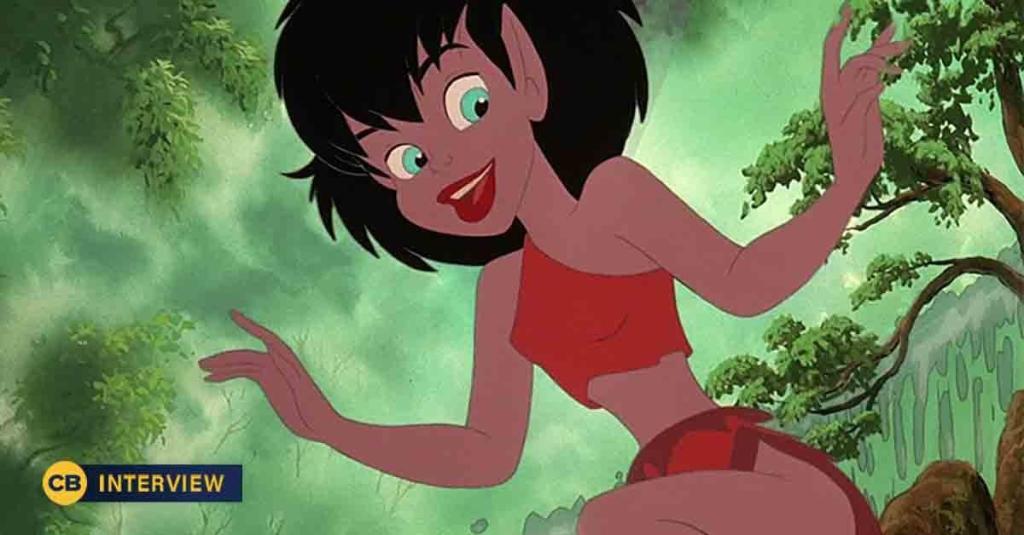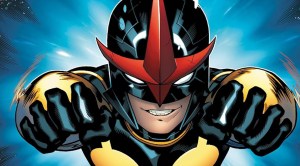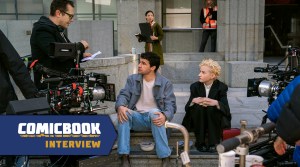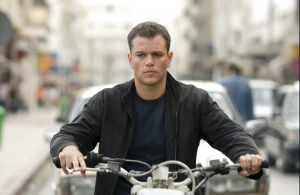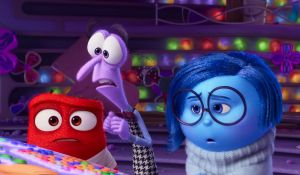It’s been 30 years since FernGully: The Last Rainforest opened in theaters with the beloved animated feature bringing to life the story of a beautiful rainforest paradise filled with tiny sprites, winged fairies, tree spirits, and all kinds of animals all living in joyful harmony who find their home threatened by humans — and one courageous sprite who must give her all to save it. Now, Shout! Factory Kids is bringing this iconic film to Blu-ray and DVD with the release of FernGully: The Last Rainforest 30th Anniversary Edition.
Videos by ComicBook.com
Available now, the Blu-ray and DVD combo features an incredible restoration from a brand-new 4K scan of the original film, as well as a wealth of special features, including a new introduction from director Bill Kroyer which includes never-before-seen pencil character and animation tests as well as multiple commentaries, featurettes, a music video, a multi-angle scene study, a script-to-scene comparison, and more.
To mark the 30th anniversary of FernGully: The Last Rainforest as well as celebrate the Blu-ray release, ComicBook.com sat down to talk with Kroyer about the film, how it was made, it’s important message about the world’s rainforests and more — including some interesting facts about the film, which was hand painted. Kroyer told us that the entire film comprised of 32,000 pounds — that’s 16 tons — of art, something you just don’t see in contemporary animation.
“When the movie was over, we had to pack it all up and give it to a consignment house,” Kroyer said. “And we weighed it, and we loaded the boxes into the truck. It was 16 tons. And four tons of that was paint, cell paint. So, that’s another thing you don’t get with digital animation. That’s another thing that’s kind of neat. Even when I think of that, I’m amazed at how we did it. Just all that paper, all those people drawing, all those people painting, shooting stuff under camera, just, oh gosh. And all the special effects, all the color, you know, all these things that no longer exist in filmmaking. It was like another age. But what a result.”
He also spoke about getting FernGully: The Last Rainforest ready for this 30th anniversary edition, explaining that he was involved in doing all of the transferring to high resolution, leading to the “best version ever” of the film.
“Shout! Factory let us, let me and the art director come back to Los Angeles a couple months ago and we did all the color timing transferring of this to the new high resolution, high dynamic range version that you’re going to watch in this Blu-ray. And it is the best… Excuse me, it’s the best version ever. I mean, our jaws were dropping because, remember FernGully was handmade. It’s paintings and painted cells. It’s not digital. It’s not resolution dependent. And then it was filmed on film, so it’s emulsion. So, when we transferred from the emulsion of film to high resolution, high dynamic range digital, it was gorgeous,” he said.
“I think when you watch it, on your screen, you’re going to be kind of immersed in that color and the beauty of the environment. It’s just really something that really pops out. It was something to see. And that’s of course, Ralph Eggleston our art director, who went on to do Toy Story and Finding Nemo and The Incredibles. He was the guy behind all that. And you can see a genius at work when you watch FernGully.”
Read on for more from our interview with Kroyer.
.
ComicBook.com: It’s been 30 years since FernGully opened in theaters. Does it feel like it’s been three decades?
Bill Kroyer: It does in some ways. In other ways, it’s so alive because FernGully had one of the happiest crews that I’ve ever experienced in making a movie. It was almost like a family. We have reunions every five years with almost the entire crew. And everybody stays in touch, so in a weird sort of way, it’s never really stopped for me because I still see all the people I know, all the animators, background painters, the ink paint people, production managers. We still talk to them and see them. And every one of them will tell you, if you ever went into one, that it was the best experience they ever had making a movie. And I like to think that comes across on the screen.
I watched it as a kid… watching it as a teen, I don’t watch it with the same eyes I do now. I know watching it as an adult, it just really does seem like there’s a lot of love there.
You know, I think being a completely handmade film has a lot to do with that, because people who are not separated from the art by a keyboard and the screen, but are actually holding the artwork in their hands, they’re drawing, they’re painting, they’re polishing, they’re carefully hand inking cells, I think that you’re so immediately connected to the artwork that I think that that feeling creates a different feeling, not only the crew, but I always thought that came through in the art. I guess I had this kind of weird mystical feeling that somehow the art would emanate that kind of love and care and it was just better. I think there’s something special about handmade films.
Looking at this, I love that the film is getting a 30th anniversary Blu-ray from Shout! Factory. I just love how it looks. It does have this almost completely different, ethereal quality to it that I don’t think we see as much anymore and I think it really does come from that, the handmade feel, which is so interesting.
Well, it’s interesting you should say that because, FernGully is, I think, completely unique in that look because of one thing, is that rather than try to create a… Animation’s called world building where you create a fantasy world, our fantasy world, our mission, was to not to create a fantasy world, but to represent the actual real world with the magic that it contains. And I don’t think any film has ever done that. Every single blade of grass, every flower, every tree, every animal in FernGully exists in the Australian rainforest.
We went down there and did tons of research. And then we came back, and we made it our mission to say, this is a movie whose message is about saving a magical place. And it’s not a fantasy. This magical place exists in the world. And we want you to realize that this is here, and this is something that’s worth caring about saving, so I think that’s why the look of FernGully is so unique from any other film.
.
That’s something that actually really surprised me. I hadn’t realized that y’all actually went to Australia to this remote rainforest. Again, young me was like, this is just so cool. And now I’m like, you guys really went there. Walk me through a little bit of how, because that’s unheard of. I mean, that’s unheard of now and that’s unheard of in the ’90s. How did that come to be part of the process of this movie?
Well, people were starting to do little research trips. They were starting that back then. But this was a trip that had to be made because, the producers, the Australian producers, they kind of had that as part of the mission statement. They said, this is a movie about all… This is about not just the Australian rainforest, not just rainforests. It’s a movie about nature. It’s about loving nature and appreciating nature and protecting nature. But they said in this case, because this is the place where it takes place, it’s really, really important for you to go there and to learn about it and to see it.
And all the things in the movie, like the fairy circle, and all the animals, the leaches, the glowing fungus. Who in the world ever saw glowing fungus on trees like that. We never saw anything like it. Or the cave, with all the little glowing… that’s all real stuff. We didn’t make that up. I think it gave an extra kind of dedication for the whole crew to be making a movie with that kind of sincerity.
.
To say FernGully changed my life is no exaggeration. It marked the first time I became aware of environmental issues, and I know immediately after seeing the film, it started changing how I personally interacted with the world even as a young teenager. I think there are a lot of younger Gen Xers and millennials who also saw this movie and it framed our relationship with the environment. It feels now like the message of FernGully is still timely, but perhaps even more timely now. What do you hope that people take away from this 30th anniversary edition of the film?
I think you’ve just said it. I think it is more timely and more important to learn the lesson of FernGully today than ever. And I’ve always rejected this idea that FernGully was in any way a political statement. It is an absolute truth, an absolute principle of life that that idea of the web of life is how we all live on this earth. We live with each other, and we live with nature, with animals, with plants. That’s how we do it. We aren’t separate. It’s impossible to be separate. We’re all connected by the web of life. And that’s the thing that I hope that kids and anybody that watches it are reminded of now when they see it, is that, wait a minute. I do have some role here. Everything I do and everything I say and the way I live has some connection to everyone else and I should be more conscious of that.
I’m really interested to see how this very ‘we’re all connected’ approach to it really impacts the younger folks.
I used to get letters from the logging lobby, as if I was anti-logging. We were never anti-logging. It’s just common sense land management. You don’t clear cut rainforest. That doesn’t make any sense. That’s just kind of a greedy and dumb approach as anybody who really studies the issue will tell you. It’s all about a more conscious way. That’s all it is. More careful and conscious way to care for everything. And it’s really taking care of yourself. That’s what you’re doing. You’re really caring for yourself when you think more carefully about the environment and how you deal with it.
The other thing I hope your kids will pay attention to in this movie is something they are not seeing anymore, and that’s hand drawn animation. This is one of the last, truly, fully animated hand drawn films. And that the way the characters, the performance of the characters and the way it works is so different from CG. And when you watch them, there’s a magic there because remember, the animator doesn’t have to obey any laws of physics or dimensionality or structure, they just have to draw something that you believe in. And so that’s why, when you look at these characters, that you go, well, wait a minute. How can those eyeballs move around like that? It doesn’t matter because it was just drawn. And that’s one of the, I think, one of them were captivating and fun things about the movie.
.
Looking back now, what are your favorite moments or memories from making FernGully and what are you most proud of?
I have to say, obviously having made a film under… It’s always tough to make a movie with a relatively low budget and a very tough time schedule and have it come out so beautifully, I’m very proud of that. But I’m also really proud of the fact that our crew was the happiest crew on any movie. And if you ever talk to any of them, they’ll tell you it was the best experience. And we have reunions every five years. Nobody does that. And we’re still close to almost everybody. Everybody’s still good friends of ours and we still see them. In a way I think that’s one of the things that I like to think, again, comes across, is that FernGully was a true labor of love that everybody bonds with it.
.
One of the things that jumped out at me was that in the commentary track… the song “If I’m Gonna Eat Somebody (It Might As Well Be You). Did I hear correctly in that commentary that Jimmy Buffet actually wrote that song?
Yes. The billionaire wrote that song. How about that? I mean, I think FernGully probably has the most eclectic collection of music of any movie. I mean, when you look at all the different authors and songwriters, but yeah, Jimmy Buffet, he came into the studio, and I went through the sequence with him. And I said, so, and I have the sequence with the Goanna and he kind of had some lyrics in mind and he had that thing about strange exotic stew and everything. And I went, “Well, would animals know what a stew is?” And he looked at me with this look that kind of said that you realize I’m a billionaire, right? I know what I’m doing. So anyway, he wrote the song, and it was hilarious, and it worked really well.
All the songs moved things along so beautifully. It was so much fun to work with everybody.
.
I’ve got one last question for you. Robin Williams’ performance as Batty Koda is, in my opinion, iconic. And doesn’t get as much recognition as it deserves because that bat is great and everything about it is great. What was it like working with him.
He was the most brilliant guy I’ve ever worked with, and he was, not just a genius, but the other thing is, the flip side of it was he was a complete gentleman. He was wonderful to every single person. Even the lowest PA, Robin was always friendly and polite and very genuine. He had no ego. He’d just come in and make everybody comfortable. And I always say the hardest job for me in FernGully was picking which take to use, because he would instantly get the sense of the scene and do what was written and then he’d start to improvise and do other things. And he was always brilliant.
But can you think of a better person to embody that character? Because if you think about it, Batty Koda is the center of the movie. He is the absolute symbol, the metaphor, for nature being met by man and struggling to understand why. And Robin was just, that’s what he loved about it. He loved that character and that’s why he signed on. It was his first animated voice that he ever did, and he just loved doing it. And I’ll always be so grateful now, and so happy that he did it because he was the best.
30th Anniversary Blu-ray and DVD
FernGully: The Last Rainforest:
Crysta (Samantha Mathis) is a fairy who lives in FernGully, a rainforest in Australia, and has never seen a human before. In fact, she is told they are extinct. But when a logging company comes near the rainforest, she sees that they do exist, and even accidentally shrinks one of them: a boy named Zak (Jonathan Ward). Now her size, Zak sees the damage that the company does and helps Crysta to stop not only them, but an evil entity named Hexxus (Tim Curry), who feeds off pollution.
Blu-ray: 1080p High-Definition Widescreen (1.85:1)/English DTS-HD Master Audio 5.1 & Stereo
DVD: Anamorphic Widescreen (1.85:1)/English Dolby Digital 5.1 & Stereo
English SDH Subtitles/1992/Color/Approximate Feature Running Time +/- 80 Minutes
Rated G, Canadian G
Special Features:
• NEW Introduction With Director Bill Kroyer, Which Includes Never-Before-Seen Pencil, Character And Animation Tests
• Audio Commentary with Bill Kroyer, Art Director Ralph Eggleston and Coordinating Art Director Susan Kroyer
• “Seed of the Story” – Script-To-Screen Comparison with Optional Commentary by Screenwriter Jim Cox
• “From Paper to Tree” – Making-of Featurette
• “Behind The Voice: Toxic Love” – Multi-Angle Scene Study
• Original Featurette
• “If I’m Gonna Eat Somebody (It Might As Well Be You)” Music Video
• Theatrical Trailers and TV Spots
***
This interview has been lightly edited for length and clarity.

